
- English
- ePUB (mobile friendly)
- Available on iOS & Android
About this book
Inform your own analyses by seeinghow one of the best data analysts in the world approaches analytics problems
Analytics Stories: How to Make Good Things Happen is a thoughtful, incisive, and entertaining exploration of the application of analytics to real-world problems and situations. Covering fields as diverse as sports, finance, politics, healthcare, and business, Analytics Stories bridges the gap between theoftinscrutable world of data analytics and the concrete problems it solves.
Distinguished professor and author Wayne L. Winston answers questions like:
- Was Liverpool over Barcelona the greatest upset in sports history?
- Was Derek Jeter a great infielder
- What's wrong with the NFL QB rating?
- How did Madoff keep his fund going?
- Does a mutual fund's past performance predict future performance?
- What caused the Crash of 2008?
- Can we predict where crimes are likely to occur?
- Is the lot of the American worker improving?
- How can analytics save the US Republic?
- The birth of evidence-based medicine: How did James Lind know citrus fruits cured scurvy?
- How can I objectively compare hospitals?
- How can we predict heart attacks in real time?
- How does a retail store know if you're pregnant?
- How can I use A/B testing to improve sales from my website?
- How can analytics help me write a hit song?
Perfect for anyone with the word "analyst" in their job title, Analytics Stories illuminates the process of applying analytic principles to practical problems and highlights the potential pitfalls that await careless analysts.
Frequently asked questions
- Essential is ideal for learners and professionals who enjoy exploring a wide range of subjects. Access the Essential Library with 800,000+ trusted titles and best-sellers across business, personal growth, and the humanities. Includes unlimited reading time and Standard Read Aloud voice.
- Complete: Perfect for advanced learners and researchers needing full, unrestricted access. Unlock 1.4M+ books across hundreds of subjects, including academic and specialized titles. The Complete Plan also includes advanced features like Premium Read Aloud and Research Assistant.
Please note we cannot support devices running on iOS 13 and Android 7 or earlier. Learn more about using the app.
Information
Part I
What Happened?
- Chapter 1: Preliminaries
- Chapter 2: Was the 1969 Draft Lottery Fair?
- Chapter 3: Who Won the 2000 Election: Bush or Gore?
- Chapter 4: Was Liverpool Over Barcelona the Greatest Upset in Sports History?
- Chapter 5: How Did Bernie Madoff Keep His Fund Going?
- Chapter 6: Is the Lot of the American Worker Improving?
- Chapter 7: Measuring Income Inequality with the Gini, Palm, and Atkinson Indices
- Chapter 8: Modeling Relationships Between Two Variables
- Chapter 9: Intergenerational Mobility
- Chapter 10: Is Anderson Elementary School a Bad School?
- Chapter 11: Value-Added Assessments of Teacher Effectiveness
- Chapter 12: Berkeley, Buses, Cars, and Planes
- Chapter 13: Is Carmelo Anthony a Hall of Famer?
- Chapter 14: Was Derek Jeter a Great Fielder?
- Chapter 15: “Drive for Show and Putt for Dough?”
- Chapter 16: What's Wrong with the NFL QB Rating?
- Chapter 17: Some Sports Have All the Luck
- Chapter 18: Gerrymandering
- Chapter 19: Evidence-Based Medicine
- Chapter 20: How Do We Compare Hospitals?
- Chapter 21: What is the Worst Health Care Problem in My Country?
CHAPTER 1
Preliminaries
Basic Concepts in Data Analysis
- If you want to understand why Bernie Madoff should have been spotted as a fraud long before he was exposed, you need to understand the “reported” monthly returns on Madoff's investments.
- If you want to understand how good an NBA player is, you can't just look at box score statistics; you need to understand how his team's margin moves when he is in and out of the game.
- If you want to understand gerrymandering, you need to look at the number of Republican and Democratic votes in each of a state's congressional districts.
- If you want to understand how income inequality varies between countries, you need to understand the distribution of income in countries. For example, what fraction of income is earned by the top 1%? What fraction is earned by the bottom 20%?
- What is a typical value for the data?
- How spread out is the data?
- If we plot the data in a column graph (called a histogram by analytics professionals), can we easily describe the nature of the histogram?
- How do we identify unusual data points?
StatesAndHeights.xlsx. As shown in Figure 1.1, the Populations worksheet contains a subset of the 2018 populations of U.S. states (and the District of Columbia).

Looking at Histograms and Describing the Shape of the Data


Table of contents
- Cover
- Table of Contents
- About the Author
- About the Technical Editor
- Acknowledgments
- Introduction
- Part I: What Happened?
- Part II: What Will Happen?
- Part III: Why Did It Happened?
- Part IV: How Do I Make Good Things Happen?
- Index
- End User License Agreement